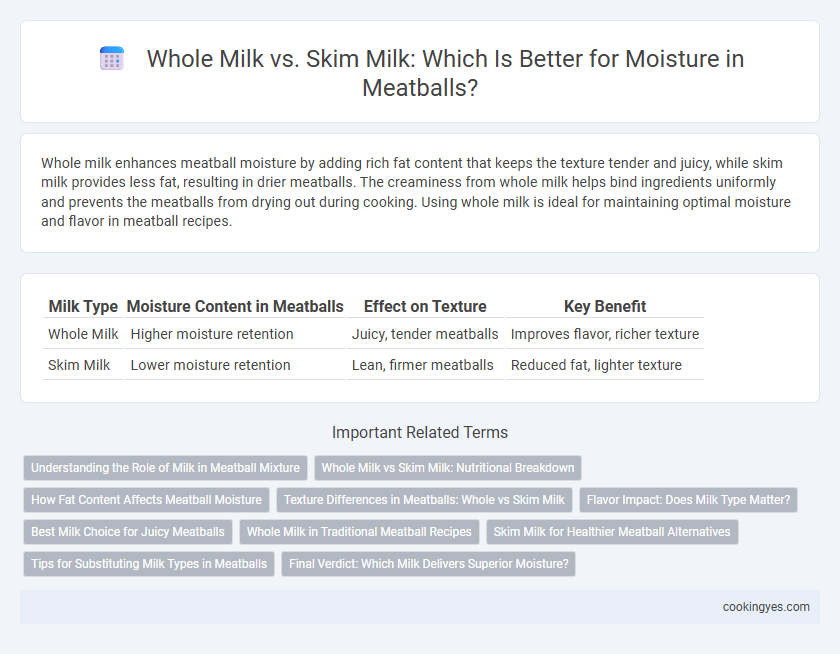Whole milk enhances meatball moisture by adding rich fat content that keeps the texture tender and juicy, while skim milk provides less fat, resulting in drier meatballs. The creaminess from whole milk helps bind ingredients uniformly and prevents the meatballs from drying out during cooking. Using whole milk is ideal for maintaining optimal moisture and flavor in meatball recipes.
Table of Comparison
| Milk Type | Moisture Content in Meatballs | Effect on Texture | Key Benefit |
|---|---|---|---|
| Whole Milk | Higher moisture retention | Juicy, tender meatballs | Improves flavor, richer texture |
| Skim Milk | Lower moisture retention | Lean, firmer meatballs | Reduced fat, lighter texture |
Understanding the Role of Milk in Meatball Mixture
Whole milk enhances meatball moisture by providing higher fat content, which helps retain juiciness and improves mouthfeel. Skim milk, with lower fat levels, contributes less to moisture retention, possibly resulting in drier meatballs. The milk's lactose and proteins also act as binders, influencing texture and cohesiveness in the meatball mixture.
Whole Milk vs Skim Milk: Nutritional Breakdown
Whole milk contains approximately 3.25% fat, contributing to richer flavors and enhanced moisture retention in meatballs, while skim milk has less than 0.5% fat, resulting in leaner but drier meat mixtures. The higher fat content in whole milk increases the tenderness and juiciness of meatballs by improving fat emulsification and moisture binding during cooking. Skim milk offers lower calories and saturated fat but may require additional moisture or binding agents to prevent dryness in meatball recipes.
How Fat Content Affects Meatball Moisture
Fat content in whole milk significantly enhances meatball moisture by providing richer fat molecules that retain water during cooking, resulting in juicier texture. Skim milk, lacking fat, contributes less to moisture retention, often leading to drier meatballs. Incorporating whole milk increases tenderness and succulence due to its emulsifying properties in the meat mixture.
Texture Differences in Meatballs: Whole vs Skim Milk
Whole milk enhances meatball moisture by adding fat, resulting in a tender, juicy texture that prevents dryness during cooking. Skim milk, lacking fat, produces leaner meatballs with a firmer, denser bite but may lead to a drier mouthfeel. The choice between whole and skim milk significantly impacts the meatball's succulence and overall mouthfeel.
Flavor Impact: Does Milk Type Matter?
Whole milk enhances meatball moisture by adding richer fat content, which intensifies flavor and creates a tender texture. Skim milk, with lower fat, produces leaner meatballs but may result in a drier texture and less depth of flavor. Choosing whole milk helps retain juiciness and savory notes, crucial for maximizing the flavor impact in meatball recipes.
Best Milk Choice for Juicy Meatballs
Whole milk enhances meatball moisture by adding rich fat content that keeps the texture tender and juicy, making it the best milk choice for succulent meatballs. Skim milk, lacking fat, can result in dryer meatballs with less flavor retention. The higher fat percentage in whole milk improves binding and moisture retention, ensuring each meatball remains moist through cooking.
Whole Milk in Traditional Meatball Recipes
Whole milk enhances meatball moisture by adding richness and fat that skim milk lacks, resulting in a juicier, tender texture crucial in traditional recipes. The fat content in whole milk emulsifies with meat proteins, locking in moisture and preventing dryness during cooking. Traditional meatball recipes rely on whole milk to achieve the ideal balance of creaminess and binding, ensuring a succulent final product.
Skim Milk for Healthier Meatball Alternatives
Skim milk offers a lower fat content compared to whole milk, reducing overall calories in meatball recipes while maintaining moisture through its high protein levels. Its whey proteins enhance water retention during cooking, preventing dryness and ensuring tender, juicy meatballs. Choosing skim milk supports healthier meatball alternatives ideal for weight management and heart health without sacrificing texture.
Tips for Substituting Milk Types in Meatballs
Whole milk enhances meatball moisture with higher fat content, creating a tender, juicy texture, while skim milk contributes less fat and drier meatballs. When substituting skim for whole milk, increase fat by adding a small amount of olive oil or butter to maintain moisture levels. Adjust seasoning and broth liquids to compensate for reduced richness in skim milk recipes to ensure flavorful, moist meatballs.
Final Verdict: Which Milk Delivers Superior Moisture?
Whole milk provides superior moisture for meatballs due to its higher fat content, which enhances juiciness and tenderness throughout cooking. Skim milk, with minimal fat, tends to produce drier meatballs by absorbing moisture without adding richness. Choosing whole milk optimizes meatball moisture retention, resulting in a more flavorful, succulent final dish.
Whole milk vs Skim milk for meatball moisture Infographic

 cookingyes.com
cookingyes.com